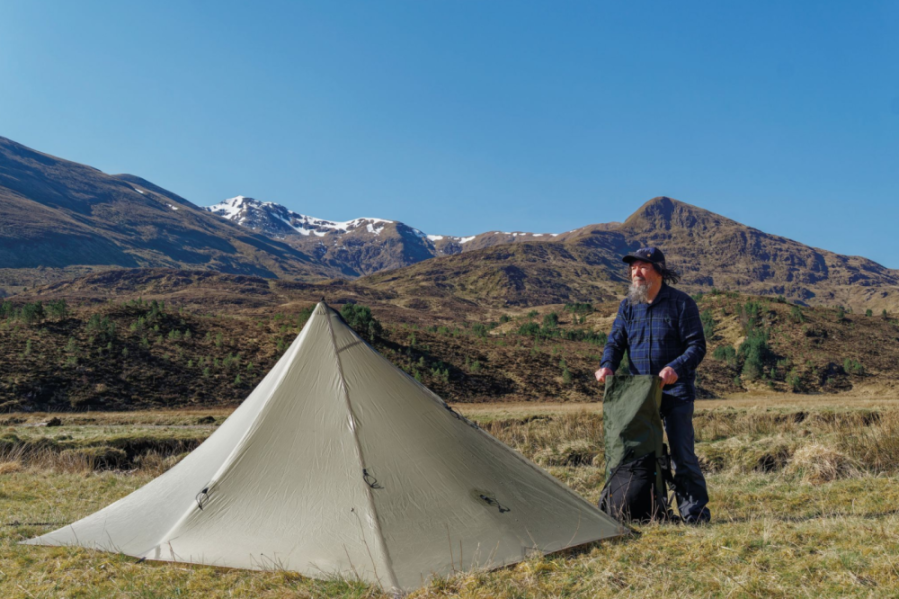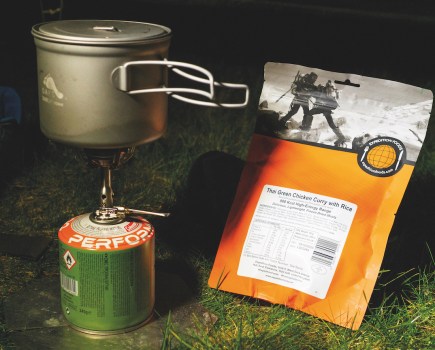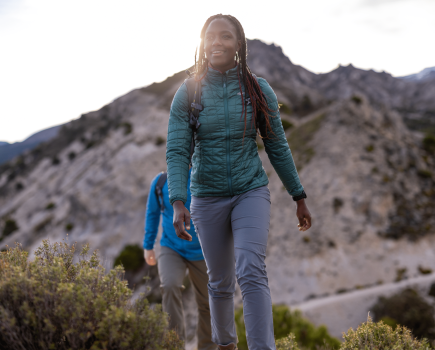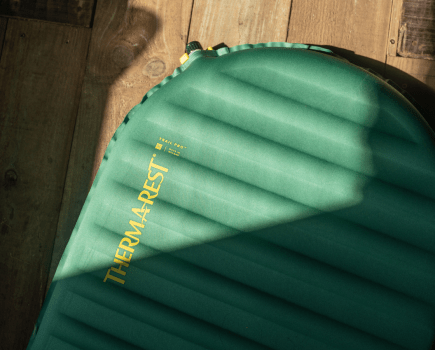Outdoor experts Chris Townsend and David Lintern highlight some of the best 1 person backpacking tents.
The best 1 person tents for backpacking will involve the right balance between weight, space and durability. Tiny backpacking tents with just enough room to lie down but none for sitting, storing gear, cooking and eating may be ultralight but they’re not suitable for comfortable living in a storm and then, at the other end of the scale, large tents like family camping tents might be comfortable and offer liveability, but they will often be too heavy to hike with.
Testing conditions
In this article, Chris Townsend and David Lintern reveal the results of their solo tent testing. The majority of options are 1 person designs though there are a couple of two-person options that will be light and packable enough for solo trips too.
Chris Townsend
Chris tested these backpacking tents in the Scottish Highlands, mostly the Cairngorms, in 2023. Sites were both high and low level and at times the tents were subjected to more severe weather than they are designed for. Note: weights are for the tent complete with stuffsacks.
David Lintern
David tested these tents between summer 2023 and spring 2024, meaning that all were tested to their design limits and in many cases, well beyond! They were used across the Scottish Highlands everywhere from riverside and woodland camps to mountain tops, in high winds, extreme cold, rain and snow. All weights are from David’s digital scales and include complete units including stuff sacks and pegs where supplied. Measurements were made with a tape measure in the field.
The best one-person backpacking tents for solo adventures
Trekkertent Saor
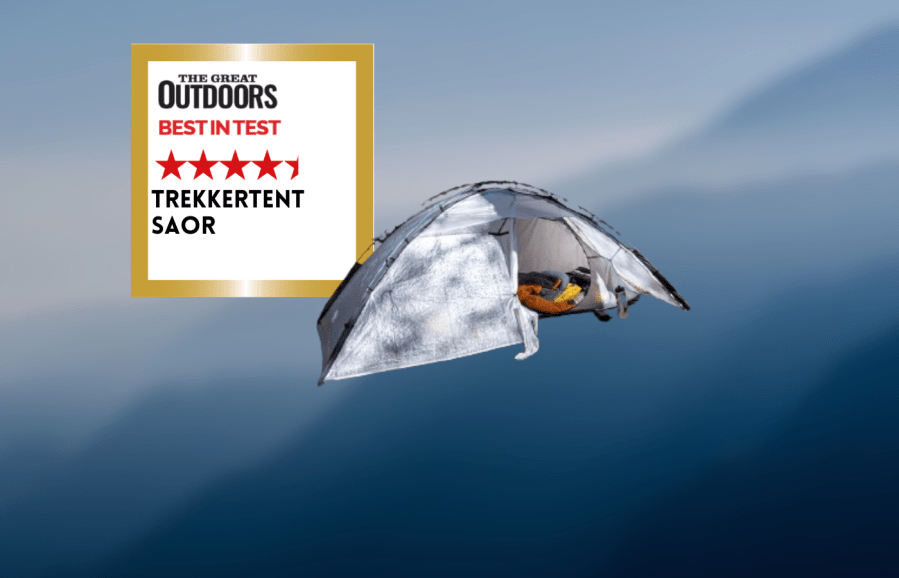
David Lintern’s Best in Test
This is a superb shelter for nearly every eventuality. Just remember to buy some pegs to go with it.- Weight
- Space
- Weather resistance
- Price
| Quick specs | |
|---|---|
| Price: £732 Weight: 1163 (not including pegs) Pitching: fly first, or as a unit Flysheet: 0.8 oz DCF, 20,000mm Hydrostatic head (silnylon also available) Inner: solid with mesh door, breathable ripstop nylon with DWR (mesh also available) Groundsheet: Silpoly PU 4000, a silicone/PU blend, 4,000mm Hydrostatic head Poles: 2x 8mm DAC Pegs: none supplied Porches: 1 Inner Dimensions: length 265cm, height 90cm, width 85cm www.trekkertent.com |
The Saor is a lightweight dome tent made by Marc at Trekkertent, featuring a Dyneema Composite Fabric (DCF) material that is lightweight, strong, and absorbs little water. It is the newer, easier-to-pitched version of the Saor and is designed for four-season use. The tent has four corners, two poles that cross in the center and slot into corner pockets, and six guying points that can be wrapped around the poles for rigidity or tied to the corner loops at ground level.
The inner, made of solid nylon, hangs in the rear via bungee attachment points and offers ample room for sitting and moving. The vestibule runs the entire length of one side and has a large beak for safe stove setup. The tent has a 2-way, weather-resistant zip for ventilation, and the door can be opened fully or halfway or zipped to create a window.
The Saor is lightweight, strong, and packs down small, making it ideal for gravel bars, coastal camping, and snowy camps. It can sleep two people without an inner, but the inner is a little baggy at the rear, which can be fixed with an extra bungee tie. Overall, the Saor is a great shelter for various situations, but it is recommended to purchase pegs to go with it.
Read David’s full Trekkertent Saor Review
Mountain Laurel Designs SoloMid XL
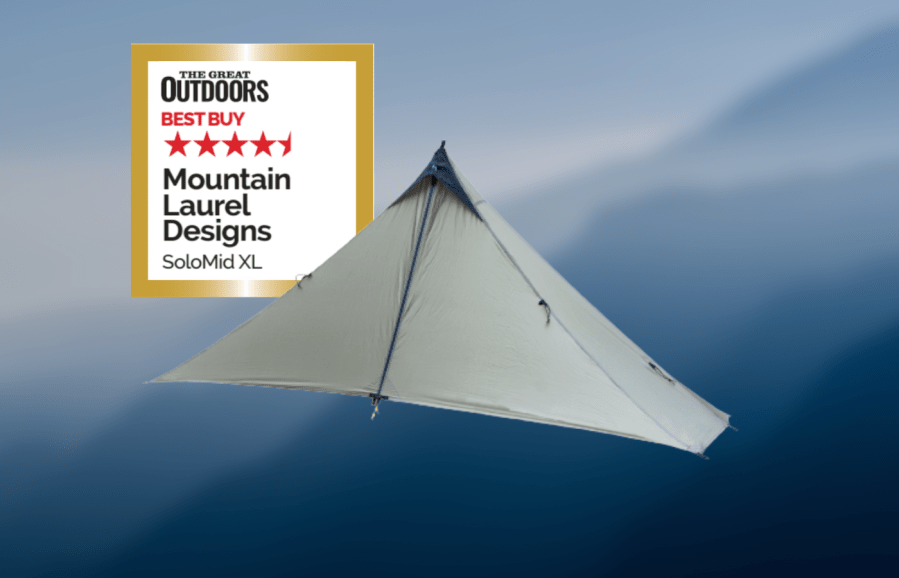
Chris Townsend’s Best in Test
The SoloMid XL has excellent headroom and masses of space for gear storage and cooking under cover. The pole is offset from the centre so there’s more space behind it for sleeping.- Lightweight
- Spacious
- Headroom
- Only available from USA
| Quick specs | |
|---|---|
| RRP: $275/£233, flysheet only Weight: 575g (flysheet only) Flysheet: 20D silpoly, hydrostatic head 5,000+mm Inner: optional silnylon/mesh Innernet tent (311g, $180/£145) Groundsheet: optional silnylon (156g, $75/£60) Poles: trekking pole or UL Carbon Fibre pole (91g, $42/£34) Pegs: not provided, optional MLD Ultimate Stake Set (133g, $42/£34) Porches: 1 with Innernet Dimensions: 280 x 142cm, max. height 140cm |
The SoloMid XL is a pyramid tent that pitches with a trekking pole, made from silpoly (silicone impregnated polyester), a material with ‘functionally comparable’ strength to silnylon. It offers better UV resistance and lower water absorption, making it easier to pitch a silpoly shelter. The tent comes with a tube of silicone seam sealer or can be sealed by MLD for an extra $60/£48.
To pitch the SoloMid XL, a trekking pole set to 140cm is needed, along with eight tent pegs. If you attach guylines to the four tie-outs on the side of the tent, another four pegs are needed. A lightweight carbon fibre pole is available for an extra £34.
The SoloMid XL has excellent headroom and ample space for gear storage and cooking under cover. The pole is offset from the center, providing more space behind it for sleeping. There is one vent at the top of the door zip covered by a hood.
The SoloMid XL can be turned into a double-skin tent with MLD’s mesh Innernet, adding 311 grams to its weight. The total weight is around 1020 grams, making it very light for such a roomy shelter. The price with the inner tent and pegs is £412, with groundsheet and pegs £342, both reasonable.
This tent was awarded The Great Outdoors Best Buy. Read Chris’ full review of the Mountain Laurel Designs SoloMid XL.
Terra nova Southern Cross 1
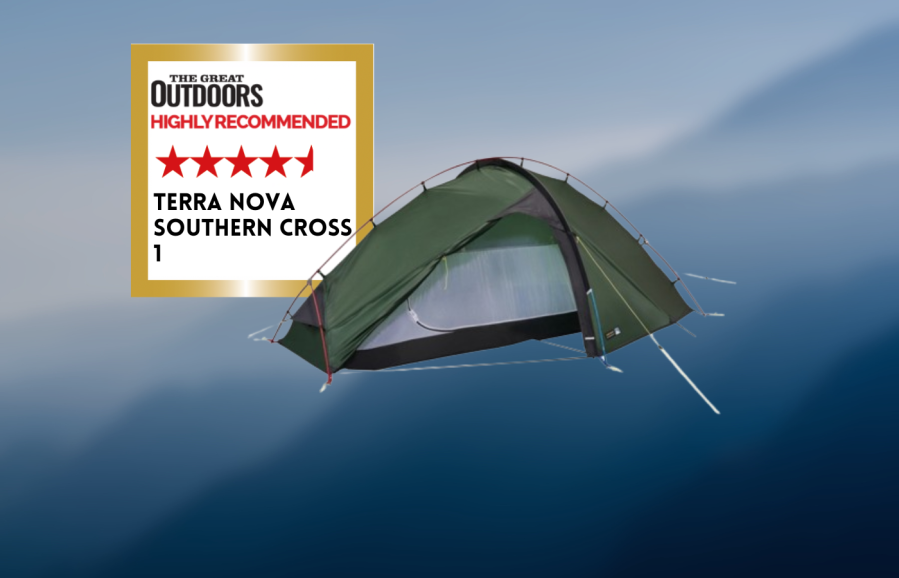
David Lintern Highly Recommends
If you are in the market for a winter capable, 2 skin shelter for British weather, this should be high on your list. At the current sale price, it’s excellent value.- Very durable
- Weather resistant
- Low headroom while lying down
| Quick specs | |
|---|---|
| Price: £700 Weight: 1771g Pitching: As a unit, freestanding Flysheet: Watershed 30D Nylon Ripstop Si/Pu, 5000mm Hydrostatic Head Inner: 20D Ripstop Nylon C0, Groundsheet: Waterbloc 70D Nylon PU, 10,000mm Hydrostatic Head Poles: 8.64mm TN Reflex x 2 Pegs: 14, 6” Y shaped Porches: 1, 55 deep x 90cm long x 90cm high Inner Dimensions: Inner 87 wide at centre, 215 long www.terra-nova.co.uk |
The Southern Cross one-person tent, part of the Terra Nova range, is a cross-framed, freestanding shelter designed to withstand most British weather conditions. It features a roomy porch, a 2-way door zip, and six main pegging points for side panels and vents. The inner is solid with a mesh door window and zipper, providing a cosy shelter on breezy nights. The living space is good length and triangle-shaped, with decent storage space at the back and a pocket. The inner is now PFC-free, but the built-in groundsheet remains reassuringly taped and impermeable.
The tent’s design has been finessed since its first iteration, and the reduced scale of single-person tents makes the Southern Cross 1 feel bomber. However, adjusting the poles and zippers can be tricky, and the poles can be fiddly. Despite these issues, the Southern Cross 1 is a winter-capable, 2-skin shelter for British weather, making it a top choice for those in the market. At the current sale price, it is an excellent value.
Read David’s full Terra nova Southern Cross 1 Review
Hilleberg Soulo
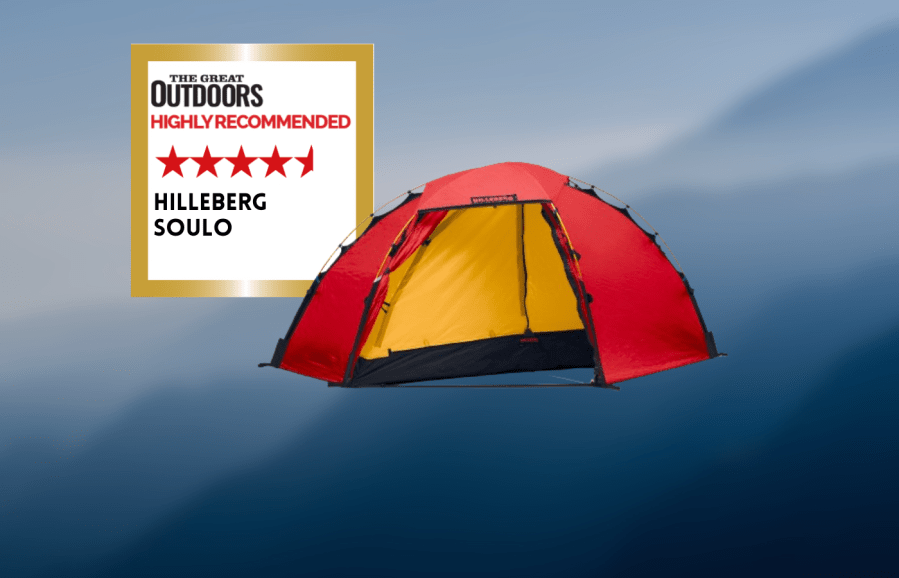
David Lintern Highly Recommends
The Soulo remains one of the most comfortable and secure all weather 1 person shelters I’ve ever used. It pitches easily, provides plenty of sleeping and storage space and sheds weather like a champ.- Generous living space
- Durability
- Weather resistance
- Weight
- Price
| Quick specs | |
|---|---|
| Price: £940 (currently on sale at ULOG for £895) Weight: 2423g Pitching: As a unit, fly first, freestanding Flysheet: Kerlon 1200 – 30 D High Tenacity Ripstop Nylon 66, Hydrostatic Head 5000mm Inner: 30 Denier Ripstop Nylon, DWR. Groundsheet: 70 Denier Nylon, Triple-coated Polyurethane, Hydrostatic Head 15000mm Poles: 3x 9mm Pegs: 12 4” V pegs Porches: 1, 75cm high x 45cm deep Inner Dimensions: length 226cm, 90cm high, width at centre 100cm hilleberg.com/eng/ |
The Hilleberg Soulo is a durable, high-quality freestanding 4 season tent with an exoskeleton design. It features two 9mm poles in pockets around the flysheet, a third pole supporting the vestibule and rear wall, and four corner pegs and 12 guy lines for extra stability. The tent has a detachable roof and a 2-way zip on the flysheet door for a covered top vent, allowing cooking in the vestibule and shelter from windblown rain. The inner has a 2-way zip and a full mesh window for warmth.
The living space is large due to high walls, with two pockets and tabs for hanging drying lines or torch. The tent is comfortable and easy to stretch out, even for taller individuals. Stuff sacks are oversized, and the guy lines and adjusters are adjustable. The Soulo is easy to use and pack, but it is relatively weighty and bulky. Despite its price, the Soulo remains one of the most comfortable and secure all-weather 1 person shelters I’ve ever used.
Read David’s full Hilleberg Soulo Review
Vaude Hogan SUL 1-2P
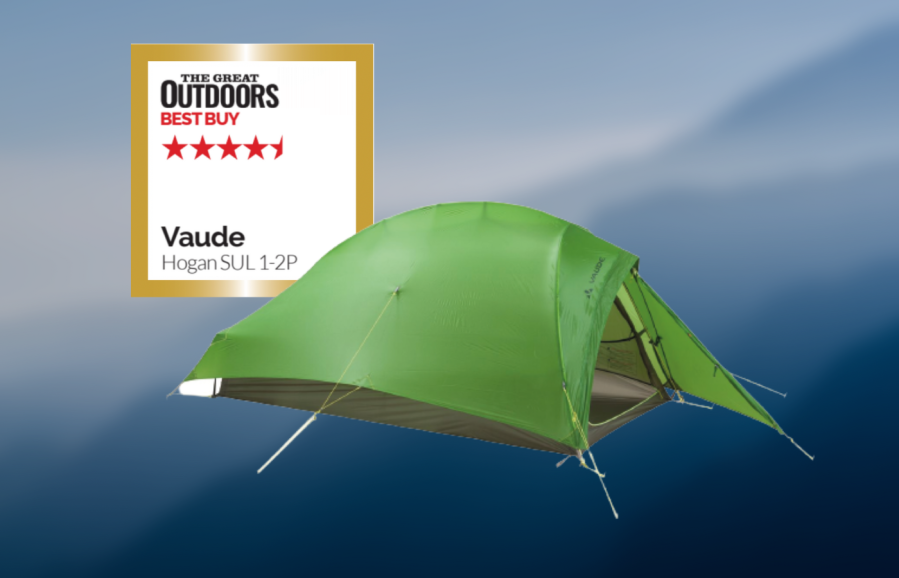
Chris Townsend’s Best in Test
Overall, this is an excellent lightweight tent, a good balance between weight and space. It’s more wind resistant than many of the others tested too.- Wind resistance
- Length
- Groundsheet hydrostatic head could be higher
| Quick specs | |
|---|---|
| RRP: $565.50 / £500 | U.S. shipping charges apply | Available from alpinetrek.co.uk Weight: 2.76 lb. | 1255g Flysheet: silicone nylon, 3000mm HH Inner: nylon/mesh Groundsheet: 30D PU ripstop nylon, 3000mm HH Poles: 8.7mm DAC NFL featherlight Pegs: 10 x 15cm X Porches: x1, 70cm deep Inner dimensions: 235cm x 110/90cm, 95cm high point. |
The Vaude Hogan SUL 1-2P is a versatile tent designed for 1-2 people, offering room and wind resistance. It is suitable for two smallish people and is good for taller individuals due to its longer length. The tent weighs 1255g and features a tripod design with a long pole attached via a hub to two shorter poles that form an arch at the front. Two upright poles at the rear corners lift the fabric and provide more inner space.
The main pole protrudes beyond the arch to create a larger porch, providing a hood over the top of the outer door zip for ventilation. Double guylines pull out the sides to allow ventilation under the flysheet, but can be pegged closer to the ground in severe weather. The inner has large mesh upper panels for ventilation.
The porch is roomy enough for safe cooking and can be used for solo use. Half or all the porch doors can be opened for good views and easy access. The tent pitches inner first, which can be done quickly in raining conditions. The flysheet is triple silicone coated and has taped seams, using a process exclusive to Vaude. The groundsheet has an adequate 3000mm hydrostatic head, though higher would be better.
In summary, the Vaude Hogan SUL 1-2P is an excellent lightweight tent with a good balance between weight and space, making it more wind resistant than many other tested tents.
Read Chris’s full Vaude Hogan SUL 1-2P review.
Rab Latok Summit
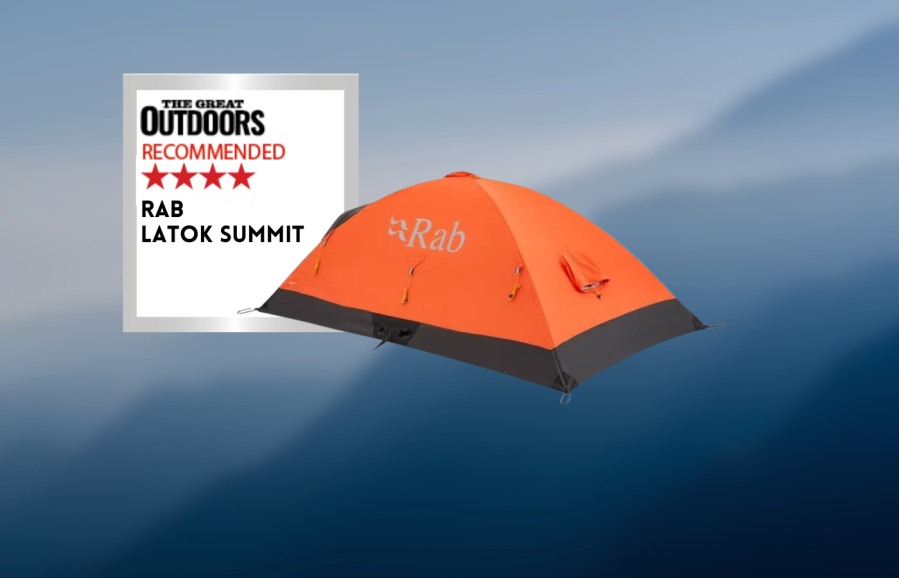
David Lintern Recommends
The Latok summit one person tent is the high altitude, cold weather specialist in this selection and as such is designed as a single skin, freestanding, 1 person shelter with a small footprint.- Weather Resistance
- Small footprint
- Breathability in some conditions
- Internal size
- Price
| Quick specs | |
|---|---|
| Price: £750 Weight: 1563g (tent 1421g, pegs 142g) Pitching: As a unit (single skin) Shell: Pertex Shield Air 15D polyamide 3L ripstop with PU membrane and polyamide backer/ 90gsm/ Hydrostatic Head: 15,000mm/ MVTR: 20,000 gm2/ DWR Liner 70D nylon with PU coated back / 160gsm / Hydrostatic Head: 10,000mm / DWR Groundsheet: Bathtub nylon with taped waterproof seams Poles: 9.6mm DAC Featherlite NSL internally pitched poles Pegs: 12 DAC V-stakes Porches: none Inner Dimensions: 110wide, 210cm long, 80cm high at crown rab.equipment |
The Rab Latok Summit one-person tent is a high altitude, cold weather specialist designed for extreme conditions. It features a single skin, freestanding shelter with a small footprint, designed to fit into tight spots in extreme conditions. The tent’s single skin fabric is Pertex Shield Air with a membrane, making it waterproof. The nylon bathtub floor has taped seams and 6 ground pegging points and 6 guylines, making it wind-resistant.
The single door is 2 way zipped from the bathtub floor upwards, part protected by a beak, minimizing snow entry and keeping ventilation high up on the shelter walls. However, the door can let snow and rain in when open, and there is no vestibule. The tent also has 4 zip ring pulls for ease of use with gloves.
The interior has steep sides and enough room for bulky winter kit storage, but the door may get wet if opened. Despite these limitations, the Rab Latok Summit is a reliable refuge in bad weather high on the mountain. It performed well between -15C and -2C in blustery weather, but not as well at the milder, more humid end.
The tent is not designed to deal with bugs and its tiny footprint may cause cramped living conditions. Additional pegs and snow stakes may be needed
Read David’s full Rab Latok Summit Review
Hilleberg Enan
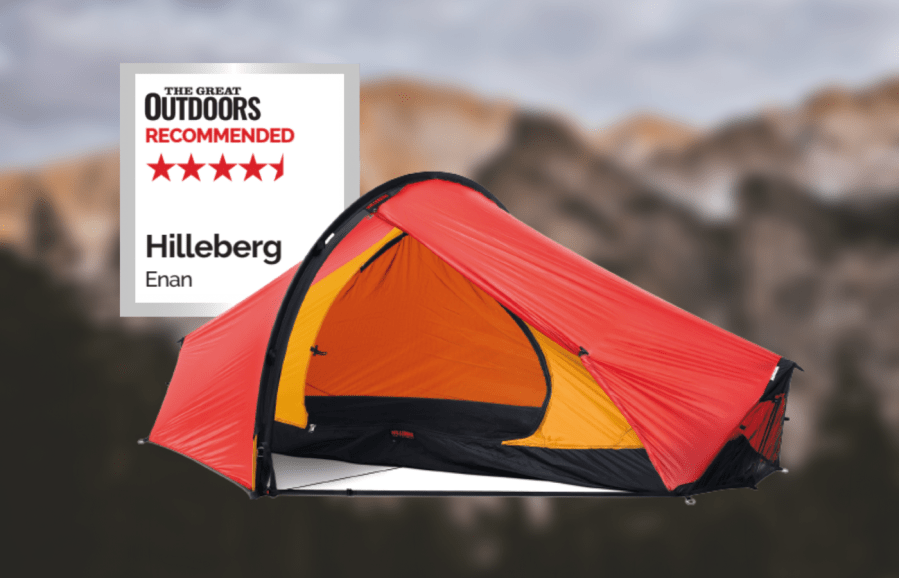
Chris Townsend Recommends
As a lightweight solo three-season tent the Hilleberg Enan is hard to fault. I think it’s superb. However, it is very expensive.- Low weight
- Porch
- High hydrostatic
- Ventilation
- Expensive
| Quick specs | |
|---|---|
| RRP: $720/£750 | Available from Alpine Trek Weight: 1100g Flysheet: 10D silicone nylon, 5000mm hydrostatic head Inner: 10D ripstop nylon/mesh Groundsheet: 70D PU coated nylon, 15000mm hydrostatic head Poles: 9mm SAC NSL Pegs: 8 x 15cm Y Porches: 1, max depth 75cm Inner Dimensions: 215 x 95cms widest, 60cms ends, 93cms max. height |
The Hilleberg Enan is a lightweight three-season tent with a mesh inner door and single short poles at each end. It weighs 1100g and has a flysheet made of 10D silicone nylon with a 5000mm hydrostatic head. The groundsheet is 70D PU coated nylon with a 15000mm hydrostatic head, making it waterproof for a long time. The flysheet ends are made of mesh with roll-down panels of solid fabric available if needed, and the top of the flysheet door can be left undone as a high-up vent. The inner has plenty of space for gear storage and headroom, and the doors roll back neatly. The flysheet fabric rustled in the wind, but this has eased off with use and doesn’t stop sleeping. The Hilleberg Enan is a superb lightweight solo three-season tent, but it’s expensive.
This 1 person tent is recommended by The Great Outdoors. Read Chris’ full review of the Hilleberg Enan.
MSR Hubba NX Solo
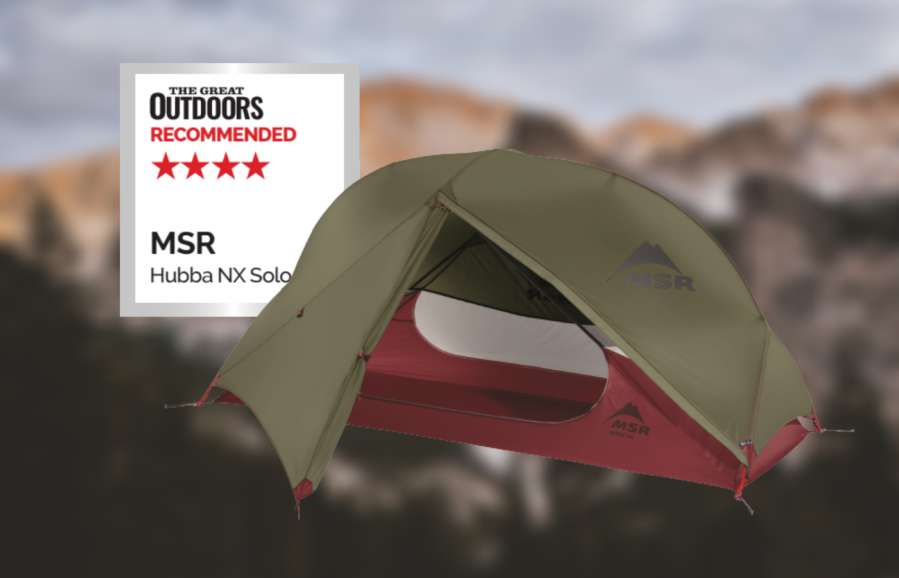
Chris Townsend Recommends
The Hubba NX Solo is lightweight, especially given the space inside. It resists winds well and is a good three-season tent.- Lightweight
- Roomy
- Big porch
- Flysheet doesn’t come right down to the ground
| Quick specs | |
|---|---|
| RRP: $533/£570 | Available from Alpine Trek Weight: 1.26kg Flysheet: silicone/PU 20D ripstop nylon, 1200mm hydrostatic head Inner: ripstop nylon/nylon micromesh Groundsheet: 30D PU ripstop nylon, 3000mm hydrostatic head Poles: DAC Featherlite NFL Pegs: 9 x 16cm MSR Needle Porches: 1, max. depth 76cm Inner Dimensions: 216 x 76cm, 91cm high point |
The MSR Hubba NX Solo is a lightweight, three-season tent with a pole with hub connections to the Y sections at the end and the ridge. It features a flysheet with a 1200mm hydrostatic head, ripstop nylon/nylon micromesh, and a 30D PU ripstop nylon groundsheet. The flysheet doesn’t come all the way down to the ground, but the groundsheet has high walls and no dampness. The inner and porch are roomy, with headroom good for six-footers. The groundsheet is rectangular, providing equal sleeping space. The inner has solid fabric above the groundsheet, wide mesh walls, and solid fabric again as the roof. The flysheet zip can be left open at the top, and the flysheet has a closable vent at the back. The tent is lightweight, resists winds, and offers maximum views, ventilation, and access.
This 1 person tent is recommended by The Great Outdoors. Read Chris’ full review of the MSR Hubba NX Solo.
Terra Nova Laser Compact AS
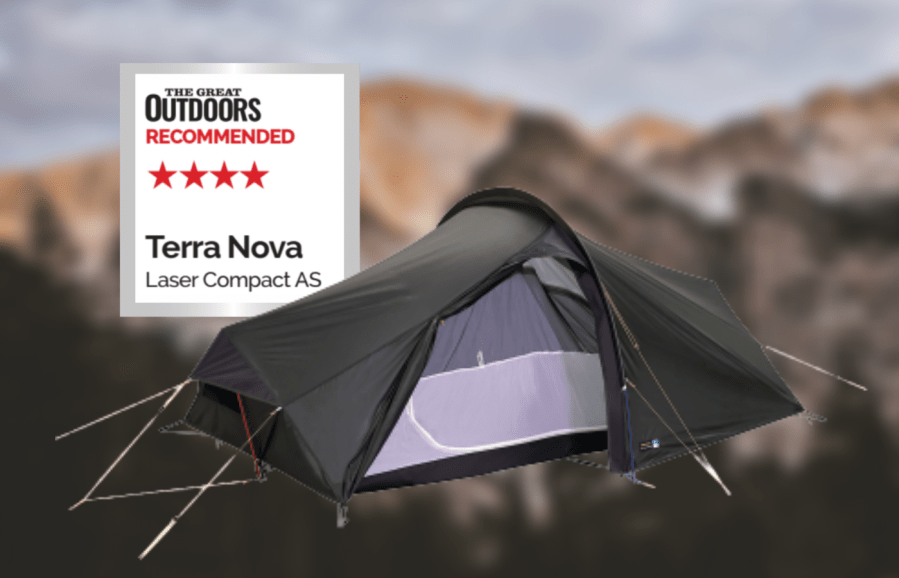
Chris Townsend Recommends
As a winter tent, the Laser Compact AS is a good choice. The design is a bit heavy for summer unless you plan on high-level camping in storms.- Weather resistance
- Roomy inner
- Tough Groundsheet
- Shallow porch
- Quite heavy
- Expensive
| Quick specs | |
|---|---|
| RRP: £690, only available in the UK & EU | Available from Terra Nova Weight: 1780g Flysheet: PFC-free 30D nylon ripstop, hydrostatic head 3000mm Inner: PFC-free 30D ripstop nylon Groundsheet: 70D nylon PU, hydrostatic head 10000mm Poles: Terra Nova Reflex Pegs: 14 x 18cm alloy Y Porches: 1, max depth 40cm Inner Dimensions: 92 x 110 x 92cm |
Unlike most of the 1 person tents reviewed the new Terra Nova Laser Compact AS is designed for year-round use – the AS stands for All Season. That means it’s built with heavy-duty materials including a groundsheet with a very high hydrostatic head and is designed to repel wind and snow. It also has extra headroom and living space over the other Laser models for comfort in cold weather. The penalty for this is extra weight. It’s also expensive.
This tent is recommended by The Great Outdoors. Read Chris’ full review of the Terra Nova Laser Compact AS.
Sierra Designs High Route 3000 1
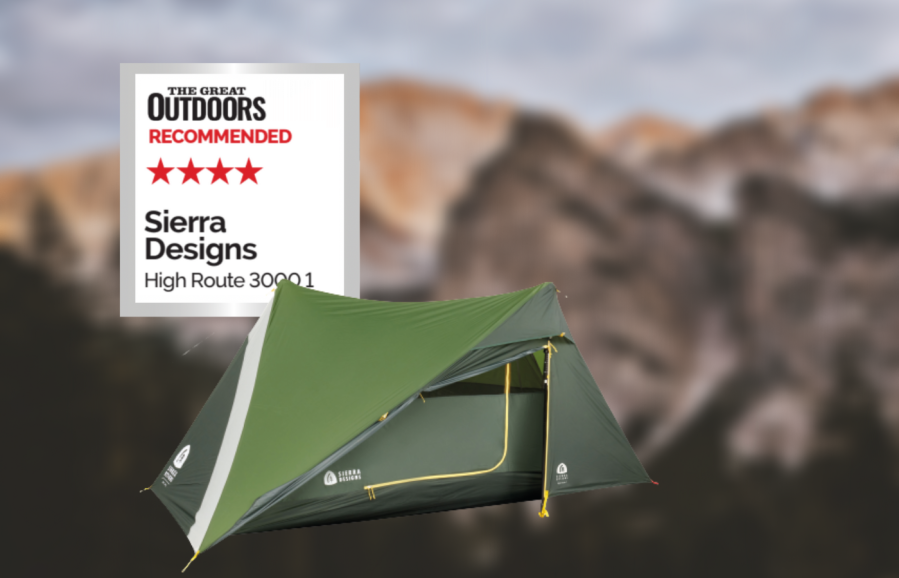
Chris Townsend Recommends
The Sierra Designs High Route 3000 1 is a great choice for midge season use, with the inner used only in midge season.- Pitches with trekking poles
- Very roomy
- makes a good tarp
- Light
- Minimal porches
| Quick specs | |
|---|---|
| RRP: $300 | £285 | Available from wildbounds.com Weight: 2.22 lb. | 1010g Flysheet: 20D nylon ripstop silicone/PU, 3000mm HH Inner: 20D nylon ripstop silicone/15D nylon mesh Groundsheet: 30D nylon ripstop, 3000mm hydrostatic head Poles: n/a, 2 trekking poles needed Pegs: 9 x 15cm Y Porches: x2, 28cm deep Inner dimensions: 259cm x 107ccm, 114cm high in centre. |
The Sierra Designs High Route 3000 1 is a European version of the one-person tent, launched in the USA a few years ago. It features a hydrostatic head of the flysheet and groundsheet, increasing durability and waterproofness. The tent’s size and design remain the same, but the fabric changes add 130 grams to the weight. The tent is designed for use as a tarp or tent, pitching with trekking poles. The inner is mostly mesh with solid panels at each end, and it clips onto the outer.
The asymmetric shape of the tent allows for a long offset ridge and vertical side walls, providing more space than standard ridges. The tent has a spacious inner with the best headroom, but the two porches are small, with one designed for storage and the other for ventilation. The main door can be pegged out as an awning for a sheltered cooking area and good ventilation. Wind resistance is reasonable, but the large panels can flap in strong winds.
Read Chris’s full Sierra Designs High Route 3000 1 review.
Nemo Hornet Elite Osmo 1p
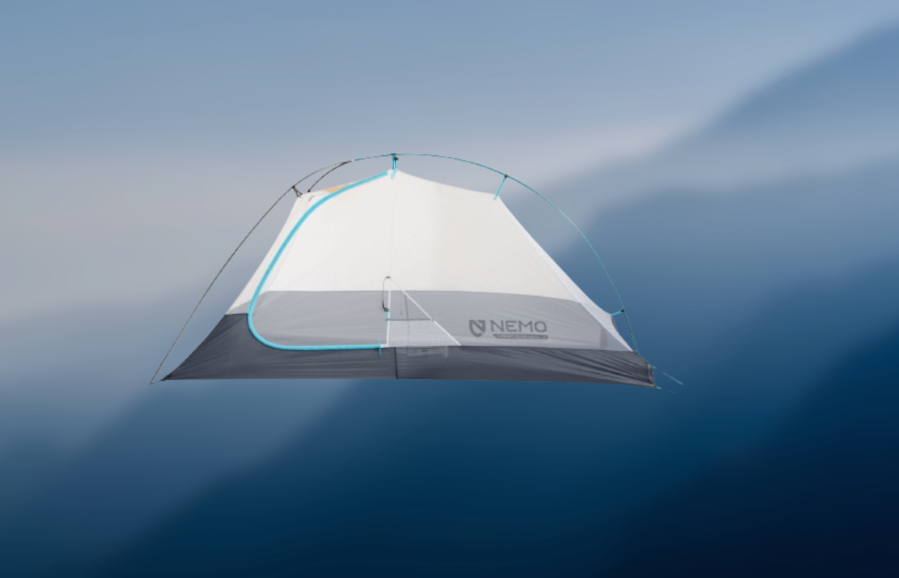
David Lintern’s verdict
It’s a really comfortable tent to use in the right conditions, but I had concerns about the groundsheet, which suffered abrasion after my first night out in the shelter.- Ultra-lightweight
- Good environmental credentials
- Price
- Poor groundsheet
| Quick specs | |
|---|---|
| Price: £520 Weight: 846g (tent, poles and bags 713g, pegs 133) Pitching: As a unit, semi freestanding Flysheet: 0D OSMO Ripstop, 1200 mm Hydrostatic Head. Inner: No-See-Um Mesh Groundsheet: 0D OSMO Ripstop, 1200 mm Hydrostatic Head. Poles: 1 Y shaped Aluminum DAC Featherlite® NFL 8.7mm pole Pegs: 6×4” Y pegs Porches: 1, 60cm deep x 1.5m useable Inner Dimensions: 86cm wide at head, tapers to approx 80cm at foot, 100cm high, 220cm long. nemoequipment.com |
The Hornet Elite is a lightweight, eco-friendly 1-person tent designed for two-season use. It features a blend of nylon and polyester, 100% recycled and free from PFCs and PFAs. The tent is semi-freestanding, with a pegged porch and a single, Y-shaped DAC pole for easy pitching. The fly is kept away by a paddle-shaped plastic at the crown, ensuring excellent ventilation. The shelter is suitable for spring and summer conditions.
There are four guys supplied, but not attached, and there are no pegs for them. The six supplied pegs are 4″, Y-shaped and robust. The living space is generous, with plenty of headroom and a single overhead night light pocket. The porch is small and may be compromised if cooking in the rain.
The tent is comfortable in the right conditions, but the groundsheet suffered abrasion after the first night. An additional footprint or thicker floor are recommended for durability. Sustainability is also important, especially at this price point. The groundsheet needs an additional footprint or thicker floor for the shelter to last.
Read David’s full Nemo Hornet Elite Osmo 1p Review
Roben’s Chaser 1
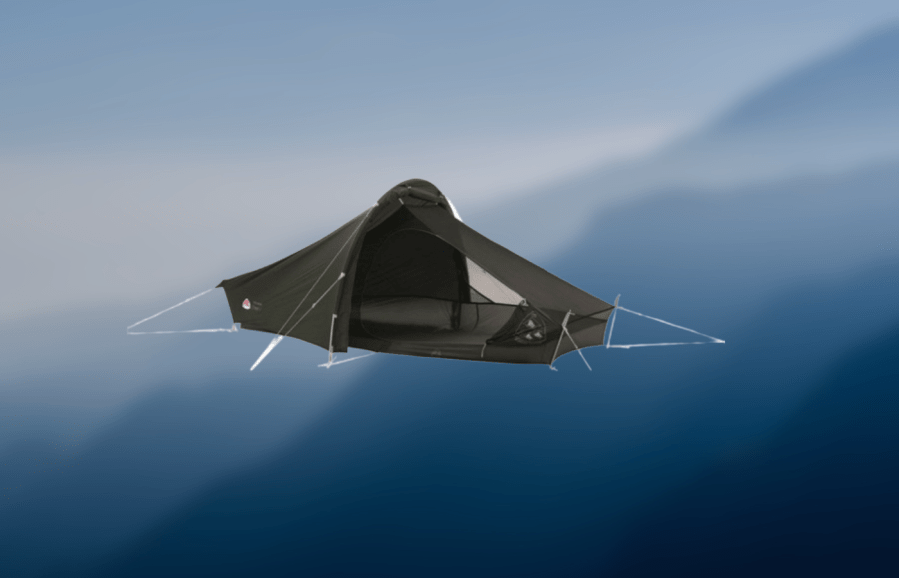
David Lintern’s Verdict
I found the Chaser very fussy to erect the first time, but once I understood the strut sleeve system, it was quick and easy to work with, and impressively stable in uncomfortably high winds.- Weight
- Price
- Wind Resistant
- Small porch
- Fussy to pitch
| Quick specs | |
|---|---|
| Price: £341 Weight: 1239g Pitching: As a unit, or fly only, or inner only. Flysheet: silicone/Pu nylon, 2000mm Hydrostatic Head Inner: 20D nylon mesh Groundsheet: 20D PU nylon ripstop, 5000mm Hydrostatic Head Poles: aluminium 7001, T6, 8.5/7.0 mm, anodised Pegs: 12 x 4” square Porches: 1, height 90cm by 35cm deep Inner Dimensions: length 245cm, width at centre 85cm, max. height 75cm URL www.robens.de |
The Robens Chaser 1 is a one-person tent with a centre hoop design and features 4 corner struts and 6 guys for stability in windy conditions. It can be configured for half-covered or open mesh shelters in more benign conditions. The pegs are small and sturdy, but can be mixed for different ground conditions. There are no vents and rain can enter the inner. Cooking is possible in the porch, but only with a two-way zipper and hood. The living space is luxuriously long, but headroom may be restrictive for taller individuals. The strut sleeve system makes it quick and easy to work with, and it is stable in high winds. The small porch may be restrictive for taller individuals, but it is a good price and versatile for warmer climates.
Read David’s full Robens chaser 1 Review
Alpkit Ultra
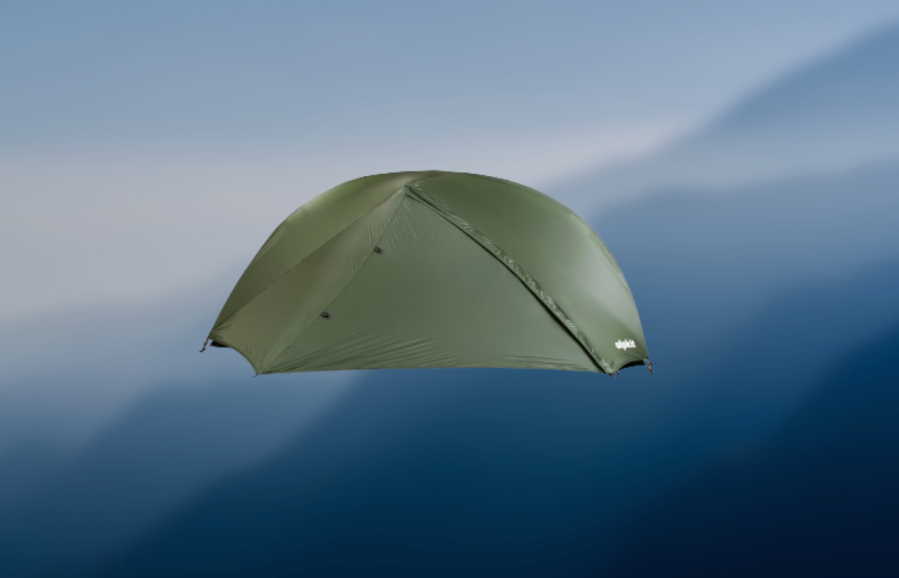
David Lintern’s Verdict
It’s a convenient weight and packsize for running or bikepacking adventures at lower elevations in decent weather, but I’d have reservations about using this over multiple nights.- Lightweight
- Small footprint
- Decent sized porch
- No headroom
- Poor pole moulding on sample
- Poor wind resistance
| Quick specs | |
|---|---|
| Price: £299.99 Weight: 943g Pitching: inner first, semi freestanding Flysheet: 10D Nylon coated ripstop nylon with PU backer, double sil coating quoted as 100% waterproof Inner: mesh Groundsheet: 15D ripstop nylon PU, 5,000 hydrostatic head. Optional Footprint (+£19.99, 125g) also 5,000 hydrostatic head Poles: 1x Y shaped Carbon fiber Pegs: 7x 4” titanium Y pegs Porches: 1 Inner Dimensions: length 200cm, height 75cm, width 75cm alpkit.com |
The Alpkit Ultra is a semi-freestanding one-person tent with a fly suspended over a single carbon fiber pole structure. It features an offset porch, smaller storage space at the rear, and no guy lines or attachment points. The inner is mesh with a sown-in groundsheet, a single pocket, and a hang loop. The groundsheet is durable but offers extra weight and cost for security. The tent has a single vent at the rear and no condensation.
The Alpkit Ultra is cramped for a 5’8″ individual, with a 12-15cm headroom that makes sitting up without touching the roof or sides impractical. The porch is decent for storage, but the roof slopes and the zip is 1 way only, making cooking in rain difficult.
The tent is suspectable to cross winds due to its low height and lack of guy lines. The carbon fiber pole flexes easily, and the prototype unit had a defective section with a poor tip/sleeve mould. The brand claims to have addressed the issue in the main production run.
While the Alpkit Ultra is convenient for running or biking adventures at lower elevations in decent weather, it may not be suitable for multiple nights, especially in the mountains.
Read David’s full Alpkit Ultra Review
Vango F10 Neon UL 1
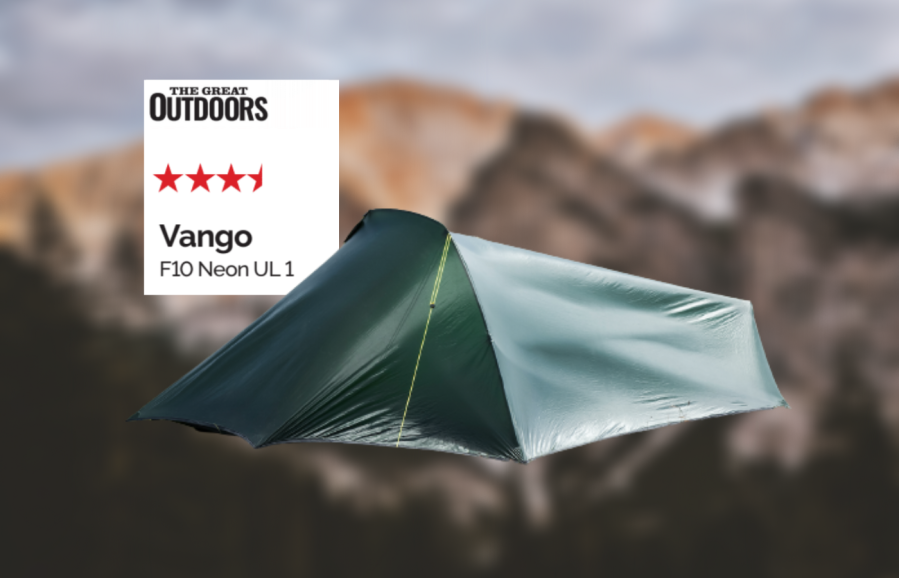
Chris Townsend’s verdict
If I had to use a shelter this size, I’d definitely choose it over a hooped bivi. If you want the lightest shelter that gives the complete protection of a tent this is probably the best there is- Ultra light
- Pack size
- Low Inner
- Tiny porch
- Joke pegs
| Quick specs | |
|---|---|
| RRP: £525 | Available from LD Mountain Centre & Vango Weight: 580g Flysheet: 7D double silicone nylon, hydrostatic head 2000mm Inner: 7D nylon Groundsheet: 10D ripstop PU nylon, hydrostatic head 6000mm Poles: Yunan UL Pegs: 12 x 13cm titanium wire, 3 x 15cm alloy Y Porches: 1, max depth 30cm Inner Dimensions: 62 x 85 x220cm, max. height 65cm |
The F10 Neon UL 1 is an ultralight double-skin tent that weighs less than many hooped bivis and is designed for minimalists who want protection from the weather. It has a better groundsheet with a hydrostatic head than some other tents, but its pegs are needle-thin titanium, which can bend easily and don’t hold well. The tent is a tapered tunnel in design and pitches as a unit, shedding wind easily. The door is on one side and long, providing easy access and good views. The porch is long enough to store trail shoes and an ultralight pack.
There is a protected vent above the door to reduce condensation, but the lack of space makes it easier to push the inner against the outer and transfer dampness inside. It’s best to avoid sitting up suddenly. If you want the lightest shelter that gives complete protection, this is probably the best option. However, it’s not for me, as I prefer tents with room for gear, sitting up, and cooking under cover. If I had to use a shelter this size, I would choose it over a hooped bivi.
Read Chris’ full review of the Vango F10 Neon UL 1.
Vaude Taurus SUL 1P
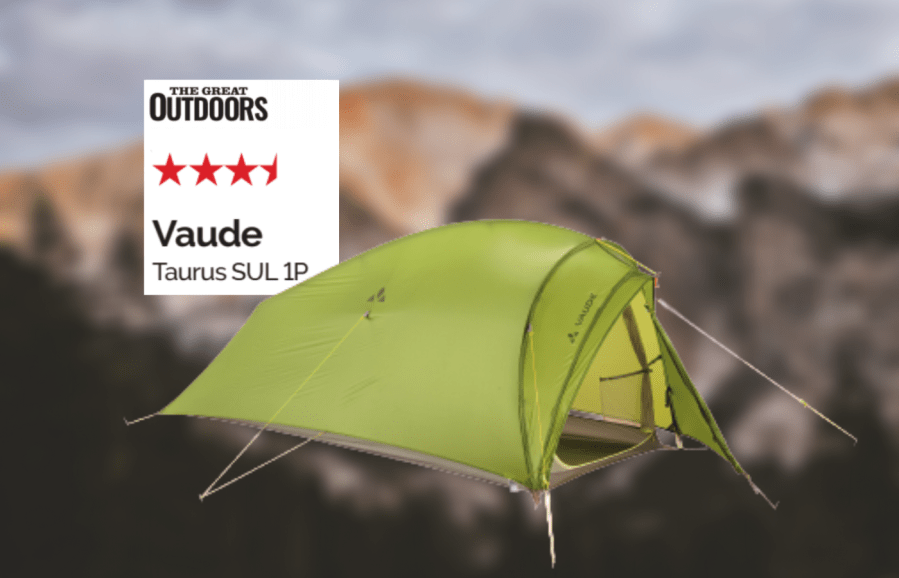
Chris Townsend’s verdict
The weight-to-space ratio and the build quality make the Taurus SUL 1P an attractive option. If only it had a larger porch.- Lightweight
- Roomy
- Small porch
| Quick specs | |
|---|---|
| RRP: £550 | Available from Alpine Trek & Vaude Weight: 1135g Flysheet: PFC-free triple silicone coated nylon, hydrostatic head 3000mm Inner: mesh door & lower walls, solid fabric upper walls Groundsheet: nylon, hydrostatic head 3000mm Poles: NFL featherlight 8,7mm Pegs: 10 x 15cm Porches: 1, max depth 58cm Inner Dimensions: 90 x 70 x 210, max. height 95cm |
The Vaude Taurus SUL 1P is a lightweight tent with a tripod construction, a long pole curving its length and a shorter hoop at the front. It offers good wind resistance, headroom, and ample space inside. The tent is made from top-quality materials, with a silicone coated flysheet on both sides and taped seams. The Taurus can be pitched quickly as a unit and features five guylines for stability.
Ventilation is excellent with mesh on the inner and a flysheet door with two-way zips with a hood over it. The inner panels are solid fabric to prevent condensation. The mesh makes the Taurus airy and not as warm in cold weather as others with solid fabric inners.
The inner has room for storing gear but not much in the porch, which is deep and sloped. Cooking in the porch requires great care. The flysheet door only opens on one side, but the whole front of the tent can be opened in good weather for access and views.
The weight-to-space ratio and build quality make the Taurus SUL 1P an attractive option, but it would benefit from a larger porch. The price of £550 makes it an attractive option for those looking for a lightweight, well-built tent.
Read Chris’ full review of the Vaude Taurus SUL 1P.
Nordisk Svalbard 1 SL
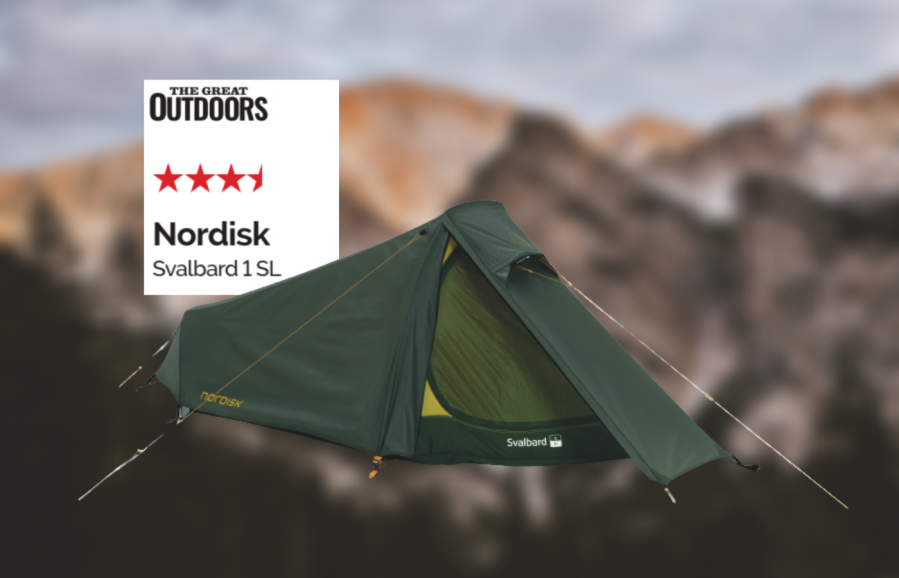
Chris Townsend’s verdict
The price of the Svalbard 1 SL is low for such a tough, well-made tent. However, it is heavy and I do wish the porch was bigger.- Good headroom
- Tough groundsheet
- Cost
- Heavy
- Small porch
| Quick specs | |
|---|---|
| RRP: $224/£316 | Available from LD Mountain Centre & Nordisk Weight: 1900g Flysheet: silicone nylon, 3000mm hydrostatic head Inner: 40D ripstop nylon Groundsheet: 40D PU nylon, 10000mm hydrostatic head Poles: aluminium Pegs: 12 x 18cm aluminium Y Porches: 1, max depth 56cm Inner Dimensions: 45 x 125cm, max. height 100cm |
The Svalbard 1 SL is a tunnel tent with a steep taper in height and width, offering excellent headroom and ample storage space. However, the low end is primarily for feet, with minimal headroom and a small porch. The fabric slopes quickly, making it difficult to cook in with the door closed, especially with a low-profile stove. One side of the door has an extra stretchy loop for a partially sheltered area, providing adequate shelter in all but the worst storms as long as the rear of the tent is pitched into the wind.
The tent pitches inner first with the flysheet clipping into place, and the tough fabrics have a high hydrostatic head for the flysheet and a very high one for the groundsheet. Hooded vents are available at the front and rear, and the inner door has mesh and solid options for airflow. The tent is designed for storm resistance rather than ventilation, and Nordisk claims it can withstand a hurricane. However, it needs to be pitched with the rear into the wind as the long unsupported side panels can bellow inwards in side winds.
Despite its low price, the Svalbard 1 SL is heavy and the porch could be bigger.
Read Chris’ full review of the Nordisk Svalbard 1 SL.
Vango Heddon 100
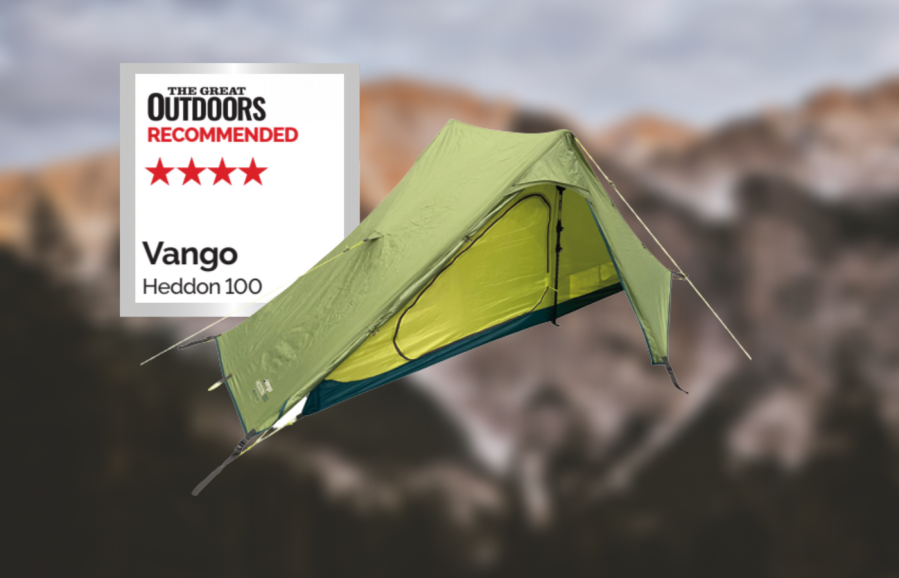
Chris Townsend Recommends
he Heddon 100 is good value for money and should last well. It stands up to strong winds well and is comfortable to live in on long cold winter nights.- Pitches with trekking poles
- Tough groundsheet
- Roomy
- Low cost
- Not that light
| Quick specs | |
|---|---|
| RRP: £285 | from vango.co.uk Weight: 3.68 lb. | 1670g Flysheet: recycled 70D polyester, 3000mm HH Inner: polyester Groundsheet: 70D polyester, 6000mm HH | Poles: n/a, 2 trekking poles needed Pegs: 13 x 18cm hook Porches: x2, 65cm deep Inner dimensions: 220cm x 85/75cm, 90cm high point |
The Sierra Designs High Route 3000 1 is a European version of the one-person tent, launched in the USA a few years ago. It features a hydrostatic head of the flysheet and groundsheet, increasing durability and waterproofness. The tent’s size and design remain the same, but the fabric changes add 130 grams to the weight. The tent is designed for use as a tarp or tent, pitching with trekking poles. The inner is mostly mesh with solid panels at each end, and it clips onto the outer. The asymmetric shape of the tent allows for a long offset ridge and vertical side walls, providing more space than standard ridges. The tent has a spacious inner with the best headroom, but the two porches are small, with one designed for storage and the other for ventilation.
The main door can be pegged out as an awning for a sheltered cooking area and good ventilation. Wind resistance is reasonable, but the large panels can flap in strong winds.
Read Chris’s full Vango Heddon 100 review.
Key features for one-person backpacking tents: How to choose a solo tent
These are some of the crucial details to look for when you’re shopping around for the right lightweight 1 person backpacking tent for solo adventures.
Materials
Silicone coated fabrics are very light and durable. PU coated nylon or polyester is heavier and less durable but costs less. The seams on silicone nylon tents aren’t usually taped – silicone is very slippery – so some makers treat the nylon with silicone on the outside and PU on the inside so the seams can be taped.
Breathable nylon or polyester resists drips from condensation and keeps out breezes. In warm weather optional mesh doors are useful. Mesh inners are cooler and airier but not as warm, especially in a breeze, and condensation can drip through unless the mesh is very fine.
You’ll find more information on the different types of tent fabrics and how to maintain them in this guide that looks at how to clean a tent.
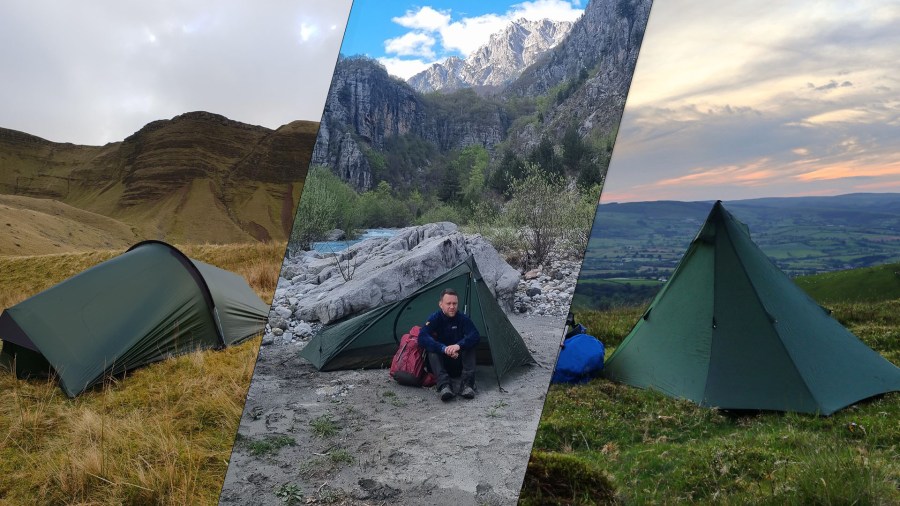
Groundsheets should be made from heavier fabrics than flysheets and have a higher hydrostatic head (the measure of how much water pressure can be applied before a material leaks). Some makers recommend using an optional footprint under light groundsheets. These add weight and cost.
Inner Dimensions
The inner should be long enough that your sleeping bag doesn’t push against the end. There should be room for a full-length, full-width (c100cm) sleeping mat without it touching either end. Headroom should be enough that you can sit up comfortably at the highest point of the inner – for me that means a minimum of 90cms.
Poles and pegs
Poles should be easy to attach. Backpacking tents with sleeves should slide in place without sticking. If the poles are different lengths, they and the attachment points should be colour-coded, so the right pole goes in the right place.
It’s useful to have a mix of different types; thin ones for hard ground and wider ones for soft ground. The ones for key pegging points and guylines should be 14-15cms long. With most backpacking tents adding a few different pegs to those supplied is advisable both for different types of ground and in case of loss.
Guylines
Guylines are the key to stability in strong winds. Extra guylines are useful in a big storm. Many tents have attachment points for these.
Porches and doors
The porch should be big enough for safe cooking and for storing hiking boots, wet gear and packs. With some tents porch space can be increased by adjusting the position of the inner or by using a guyline to peg out one side of the door as an awning.
Flysheet doors that can be opened in several ways are the most versatile. In good weather you can open them fully for easy access and good views. Unlike two person tents, most one person tents will only have one door and porch.
Ventilation
Protected vents or upper door zips that can be left open in all but the worst weather can reduce the amount of condensation that builds up in humid weather. Only close vents when you really must to prevent rain entering.
Pitching
Some tents pitch inner first, some flysheet first or as a unit. The first gives a taut inner but speed is needed in rain. Flysheet and unit pitching keeps the inner dry, but it can be hard to tension the inner. Whatever the method it’s best to practise pitching before taking a tent on a trip.

